.
This article is written to follow the first part, which was written a few weeks ago with respect to NEMMCO’s forecasts for the demand in the VIC region on the date of the heatwave, record demand and blackouts, etc….
What follows is some quick notes about the demand forecasts for the other regions.
Note that all of the charts shown below provide mixed measures of demand as measured on both:
(a) a trading (30-min) target basis, and
(b) a dispatch (5-min) target basis.
For the purposes of this discussion, this is sufficient.
.
PASA forecasts for the other regions
In the same way that we analysed the PASA forecasts for VIC in the initial article, we have also performed the same analysis for the other regions below:
.
PASA forecasts for the South Australian Region
The first chart (below) highlights how NEMMCO’s MT PASA forecast for the daily peak SA demand on 29th January converged on the actual demand experienced that afternoon.
As can be seen, the MT PASA demand forecasts is seen to converge well with the actual peak demands seen on the day.
The second chart (below) shows the “zoomed in” view of just the ST PASA forecasts, which show a similar pattern as that exhibited in the Victorian ST PASA forecasts:
1) As can be seen, the initial 10% forecasts for ST PASA started 500MW (or 14%) below the last MT PASA forecast produced. I have not had the time (yet) to learn why this would be the case – but it may be to do with the forecast timing of peak demand on the day.
2) As can be seen, the forecast was progressively refined to the stage where it lined up well with the last MT PASA forecast and (most importantly) with the actual peak demand experienced on the day.
3) Finally, it is seen that the actual demand experienced on the day was above the 50% POE forecast produced less than 24 hours beforehand (hence indicating that the demand was even higher than was the “best case” forecasts made with the knowledge that a heatwave was occurring).
PASA forecasts for the Tasmanian Region
The first chart (below) highlights how NEMMCO’s MT PASA forecast for the daily peak TAS demand on 29th January converged on the actual demand experienced that afternoon.
As can be seen, the MT PASA demand forecasts were significantly (11%) higher than the actual peak demands seen on the day.
The second chart (below) shows the “zoomed in” view of just the ST PASA forecasts, which are seen to be more accurate than in this instance.
Once again, we can see a significant revision of the 10% POE demand forecast in between the MT PASA and ST PASA runs.
PASA forecasts for the NSW Region
The first chart (below) highlights how NEMMCO’s MT PASA forecast for the daily peak NSW demand on 29th January converged on the actual demand experienced that afternoon.
As can be seen, the MT PASA demand forecasts are considerably (14%) higher than the actual demand experienced on the day (as this was relatively modest in NSW).
The second chart (below) shows the “zoomed in” view of just the ST PASA forecasts, which show how the forecasts were revised downwards to something approaching the actual peak demand experienced on the day:
As can be seen, the actual demand experienced was approaching the 10% forecast last produced in ST PASA, which seems to imply that the demand in NSW was surprisingly strong, based on expectations for weather patterns on the day.
PASA forecasts for the Queensland Region
The first chart (below) highlights how NEMMCO’s MT PASA forecast for the daily peak QLD demand on 29th January converged on the actual demand experienced that afternoon.
As can be seen, the MT PASA demand forecasts were considerably (30%) larger than the actual demand experienced on the day, which was a relatively mild demand day in QLD.
The second chart (below) shows the “zoomed in” view of just the ST PASA forecasts.
As can be seen
1) In between the last MT PASA forecast and the first ST PASA forecast, the 10% POE demand forecast was revised down considerably.
2) The actual demand experienced turned out to be closer to the 90% forecast (hence we would conclude that it was surprisingly mild in QLD).
General comments
In summary, the following things stand out to me. Some of these I would investigate further, if I had the time!
1) The MT PASA forecasts did seem to be a useful early-warning system on this day:
(a) As shown in the snapshots of NEM-Watch taken on the day, and included in this article included on the blog on the same day, the high demand in VIC and SA drove the NEM-wide demand to a new record. Hence it makes sense that the demand experienced in both VIC and SA was close to the MT PASA 10% POE forecasts generated for some time before the events:
In simple terms, the MT PASA forecasts are extreme weather forecasts, and the weather was certainly extreme on those days in VIC and SA!
(b) In contrast, the relatively mild demand experienced in NSW, QLD and TAS meant that the MT PASA 10% POE forecast was not representative of what actually was experienced on the day:
In simple terms, the weather was not extreme in QLD, NSW or TAS on the day.
(c) It is my personal view that the NEM would benefit from a holistic forecast for a 10% POE peak NEM-wide demand in MT PASA, as well.
i. This would not be the simple arithmetic sum of the 10% POE forecasts of demand in each region as it would be an extremely unlikely event that the NEM would experience extreme weather everywhere simultaneously.
ii. I have already expressed the same desire with respect to the annual Electricity Statement of Opportunities.
2) Between the last MT PASA and first ST PASA forecasts, it is seen that the 10% POE demand forecast was initially adjusted down in the case of all 5 regions.
(a) The revisions ranged from a low of 7% to a high of 30%
(b) I have not yet had time to discover why this was the case.
3) In the case of the final ST PASA forecasts, the actual peak demand on the day was:
(a) at the upper end of the range for four regions (NSW, VIC, SA and TAS) and
(b) at the lower end of the range for QLD – which presumably experienced milder weather than even that expected 24 hours previously.
.


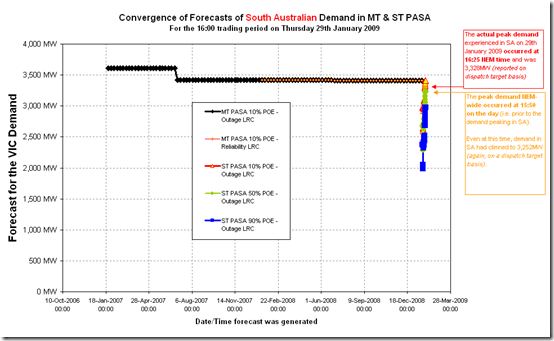
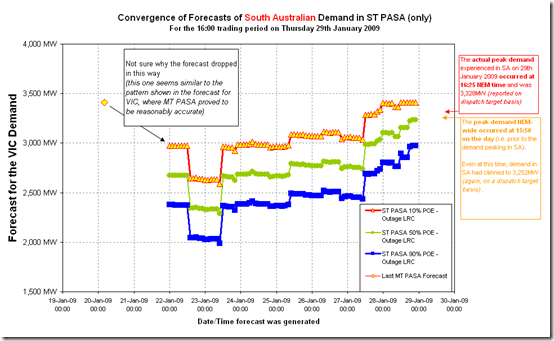
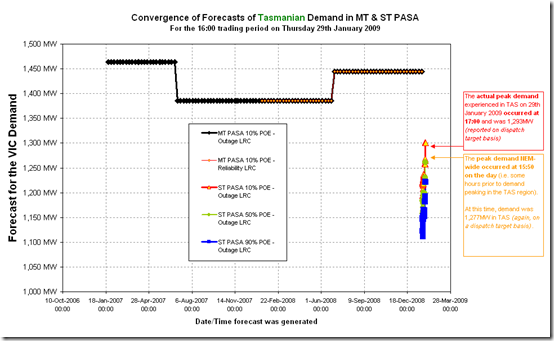
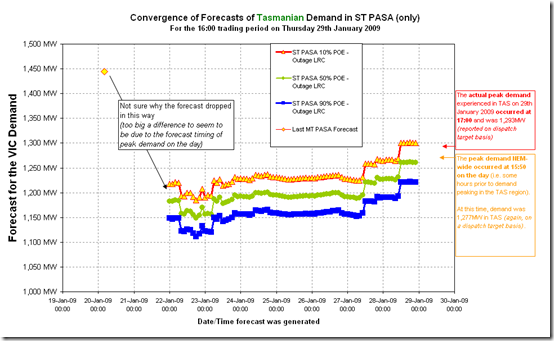
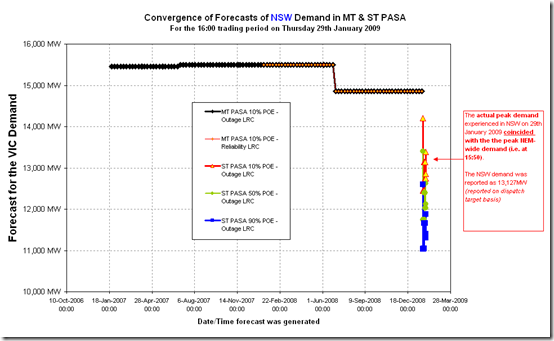
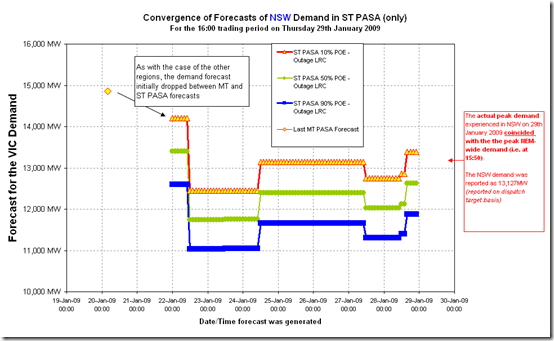
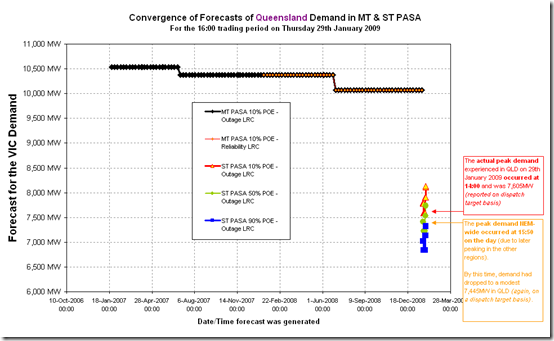
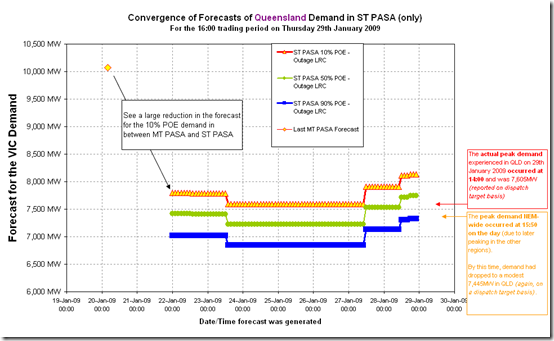
Be the first to comment on "How helpful was NEMMCOs PASA process in predicting the demand spike on 29 January 2009 (part2)"